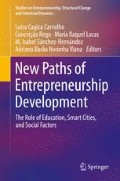Abstract
This chapter deals with the necessary connection among entrepreneurship and regional development, among entrepreneurship and digital economy. These are two of the main topics of this book. Although this bidirectional relationship can be carried out from a number of points of view, we will be focused on how higher education can foster entrepreneurship. The high rate of unemployment among young people, even after university studies, in the first decade of the twenty-first century, and their high level of education and training, make us entertain doubts if our present Higher Education System is prepared to solve this serious social problem, and if University can foster an ‘entrepreneurship culture’ in our society and help make the change in our territory.
Access this chapter
Tax calculation will be finalised at checkout
Purchases are for personal use only
Notes
- 1.
Term “skills” is used in a broad sense to what an individual knows, understand and can do.
- 2.
Communication related to Europe 2020 Strategy released in March 2010: COM (2010) 2020 (http://eur-lex.europa.eu/LexUriServ/LexUriServ.do?uri=COM:2010:2020:FIN:ES:PDF).
- 3.
The second main objective related to higher education consists on reducing the school dropout rates below 10%.
- 4.
See en DO C 119 de 28.5.2009, p. 2 (http://eur-lex.europa.eu/LexUriServ/LexUriServ.do?uri=OJ:C:2009:119:0002:0010:ES:PDF).
- 5.
Communication from the Commission to the European Parliament, the Council, the European Economic and Social Committee and the Committee of the Regions—Supporting growth and jobs—an agenda for the modernization of Europe’s higher education systems.
- 6.
A new agenda for skills in Europe. Working together to re-inforce the human capital, employability, and competitiveness”, COM (2016) 0381.
- 7.
Barometer University—Society, made by Consejo Social de la Universidad Complutense de Madrid, 2015.
- 8.
UE-ALCUE Network (University—Company from Latin American, Caribbean, and EU countries).
References
Bernal, M. (2007). Internationalization of higher education. Ed. EDUCC. Córdoba (Argentina).
Cantillon, R. (1755). Essai sur la nature du commerce en general. Institut National d’Etudes Demographiques, 1997. Reprod. facs. de la ed. de Paris: Institut National d’Etudes Démographiques, 1952. – Texte de l’édition originale de 1755.
Casco, J. C., & Barrena, F. (2011). How to create 1,000,000 new entrepreneurs in your country. Ed. Emprendedorex. Spain.
Castellacci, F. (2007). Innovation and the competitiveness of industries: Comparing the mainstream and the evolutionary approaches. Technological Forecasting and Social Change, 75(7), 984–1006. https://doi.org/10.1016/j.techfore.2007.09.002
Edquist, C. (2005, November). Systems of innovation: Perspectives and challenges. Oxford handbook of innovation (pp. 181–208). Oxford: Oxford University Press.
Etzkowitz, H. (1989). Entrepreneurial science in the academy: A case of the transformation of norms. Social Problems, 36(1), 14–29.
Etzkowitz, H. (2002). Incubation of incubators: Innovation as a triple helix of university-industry-government net works. Science and Public Policy, 29(2), 115–128.
Etzkowitz, H. (2003). Innovation in innovation: The triple helix of university- industry-government elations. Social Science Information, 42(3), 293–337.
Etzkowitz, H., & Leydesdorff, L. (2000). The dynamics of innovation: From national systems and ‘Mode 2’ to a triple helix of university-industry-government relations. Research Policy, 29(2), 109–123.
European Commission. (2006). European innovation progress report 2006. European Commission, DG Enterprise and Industry, Brussels. Accessed April 9, 2008, from http://www.proinno-europe.eu/docs/Reports/Documents/EIPR2006-final.pdf
European Commission. (2007). European innovation scoreboard 2007. Comisión Europea, Programm Pro Inno Europe, Bruselas. Accessed April 9, 2008, from http://www.proinno-europe.eu/admin/uploaded_documents/
Fernandez de Lucio, I. (2015). Myths and realities of linking universities -ES, (Ingenio-UPV). Paper presented at the Third Congress of the Universidad Empresa Alcue, Buenos Aires 20 to 25 October. Recovered to http://tercercongreso.redue-alcue.org/ponencias/
Hughes, A. (2007). Innovation policy as cargo cult: Myth and reality in knowledge-led productivity growth. Centre for Business Research, Working Paper No. 348. University of Cambridge, UK. Recovered to http://www.cbr.cam.ac.uk/fileadmin/user_upload/centre-for-business-/wp348.pdf
Leydesdorff, L. (2006). The knowledge-based economy and the triple helix model. In W. Dolfsma & L. Soete (Eds.), Reading the dynamics of a knowledge economy (pp. 42–76). Cheltenham: Edward Elgar.
OECD. (2007). And innovation in Spain: Improving the instruments. OCDE, París. Accessed April 9, 2008, from http://www.plannacionalidi.es/inicio/diagnostico/estudios/documentos/espanol%20OCDE.pdf
Rubiralta Alcañiz, M. (2004). Transfer to university research companies. Description of European models. Fundation Cotec four Technological Innovation.
Toffler, A. (2006). Revolutionary Wealth, 30(4), 122–130 (October 2013).
UNESCO. (1998). World declaration on higher education for the twenty-first century. Available from http://unesdoc.unesco.org/images/0011/001163/116345e.pdf
Uribe, J., & De Pablo, J. (2011). Reviewing entrepreneurship. ICE Economic Bulletin No. 3021, December, pp. 53–62.
Viale, R., & Etzkowitz, H. (2004). Third academic revolution: Polyvalent knowledge: The ‘DNA’ of the triple helix. http://wwww.triplehelix5.com/files/thc5_themepaper.pdf
Vidal, M. (2000). Against the subsidy culture. Ed. Gestión 2000. Spain (2010).
Author information
Authors and Affiliations
Corresponding author
Editor information
Editors and Affiliations
Rights and permissions
Copyright information
© 2019 Springer Nature Switzerland AG
About this chapter
Cite this chapter
Yuste, M.A. (2019). Higher Education and Technological Transference as Tools for Entrepreneurship in Regional Development. In: Cagica Carvalho, L., Rego, C., Lucas, M.R., Sánchez-Hernández, M.I., Backx Noronha Viana, A. (eds) New Paths of Entrepreneurship Development. Studies on Entrepreneurship, Structural Change and Industrial Dynamics. Springer, Cham. https://doi.org/10.1007/978-3-319-96032-6_7
Download citation
DOI: https://doi.org/10.1007/978-3-319-96032-6_7
Published:
Publisher Name: Springer, Cham
Print ISBN: 978-3-319-96031-9
Online ISBN: 978-3-319-96032-6
eBook Packages: Business and ManagementBusiness and Management (R0)

